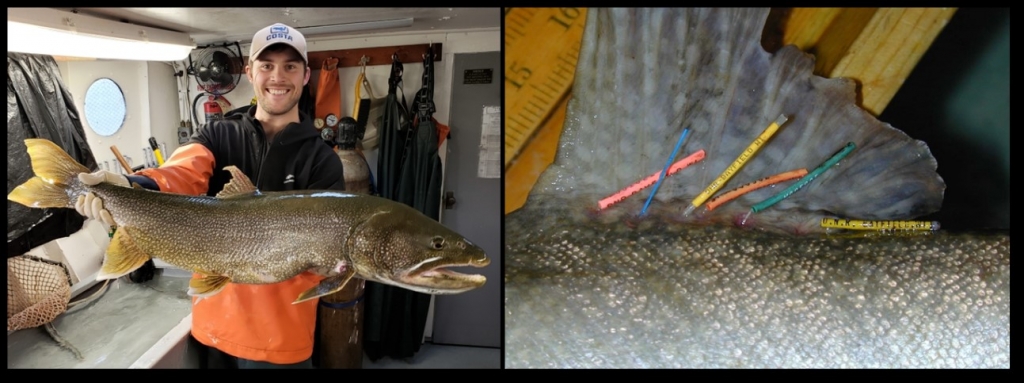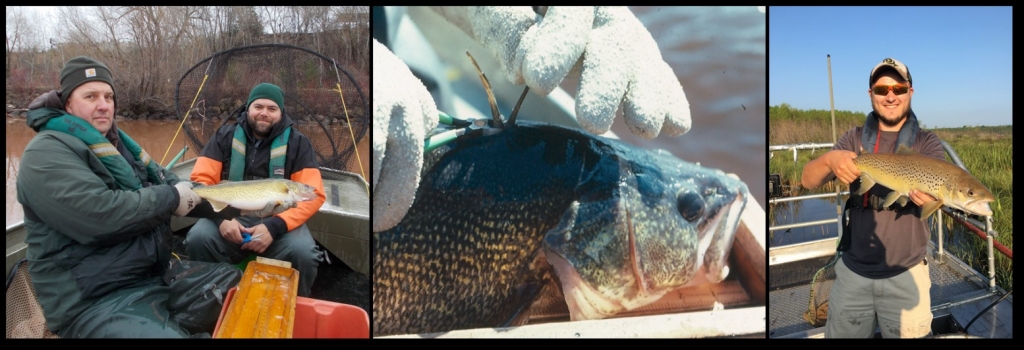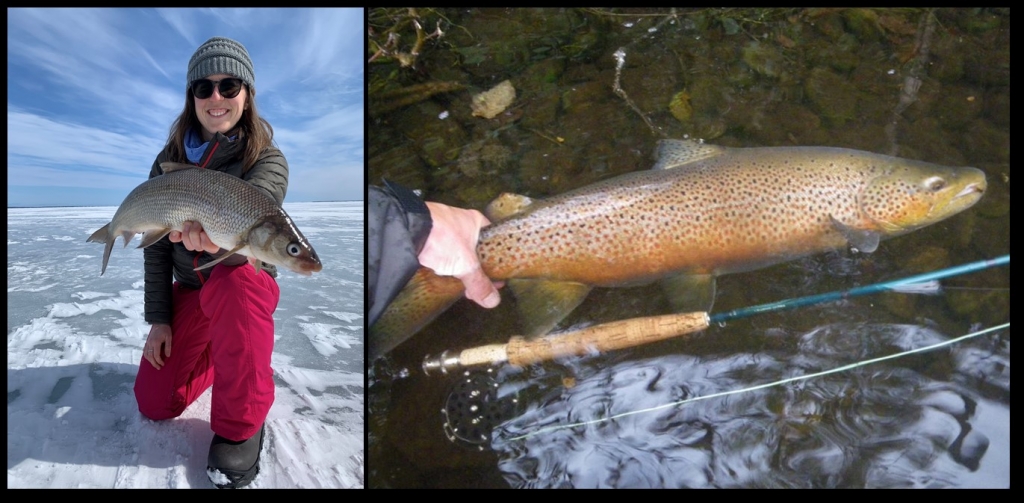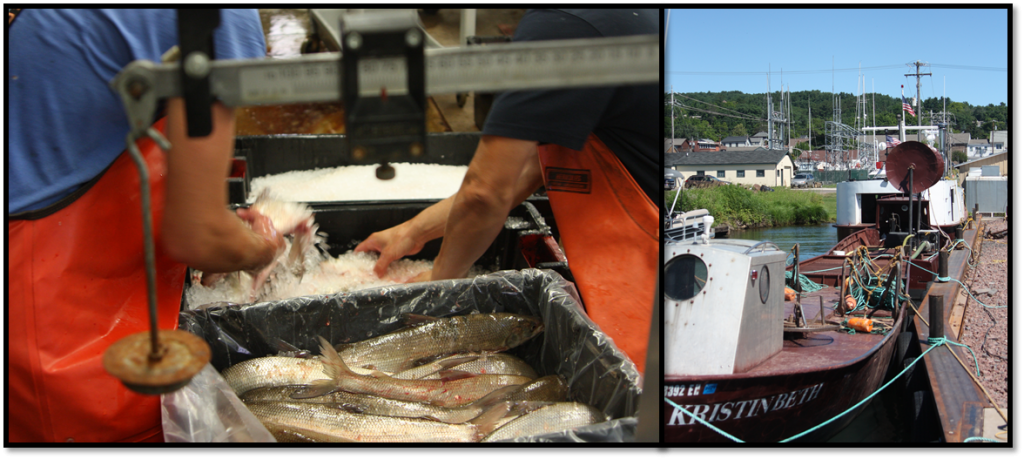Lake Superior Management Reports
Fishing Wisconsin
FISHERY ASSESSMENT REPORTS
Fishery assessments are a critical component for guiding fisheries management decisions on Lake Superior and its many tributaries. Fishery-independent assessments are one strategy employed by the Lake Superior Fisheries Management Team to gather unbiased data on a fish population. Types of gears used in these assessments vary from gill nets and hydroacoustics sonar on the R/V Hack Noyes to small fyke nets and backpack electrofishing systems in Lake Superior’s tributaries and nearshore areas. The foundation behind these assessments is standardization. For example, in a gill net assessment, we set nets with the same dimensions, at the same time of year, for the same amount of time, and in the same locations each time we do the assessment. In doing this, we can assume that any changes we see are likely due to changes in the fish population we are assessing. During these assessments, we also collect biological data from individual fish such as lengths, weights, fin clips, scars, tag information, etc. Often, we also collect aging structures, such as a dorsal spine or otolith, which allows us to estimate the age of individual fish in our lab. This information is critical for our ability to evaluate things such as fish growth rates and mortality rates. Fishery-dependent surveys are also used to monitor sport and commercial harvest.
The management reports contained on this page are updated regularly and contain information from our Lake Superior program on a variety of topics.
Wisconsin's Lake Superior Plan Reports
South Shore Tributary Assessments
Understanding the early life history of trout and salmon and their contributions to Lake Superior go hand-in-hand when providing sound management decisions for all anglers throughout the watershed. Most south shore tributaries up to the first impassable barrier are regularly surveyed on a 1, 6 and 12-year rotation. This schedule contains over 120 stations across 55 cold-water streams, with eight stations surveyed annually. These ‘Trend’ stations are multi-purpose: 1.) they provide a representative sample size to gauge annual reproductive success of lake-migrating fish species across Bayfield County, 2.) monitor long-term trends in stream resident fish and 3.) locate and prioritize future collaborative habitat restoration projects. Both Trend and Rotation stations estimate the relative abundance of fish using a standard sampling design and active electrofishing gear types (i.e., backpack or stream barge), depending on stream width. A common measure of relative abundance is catch per unit effort, which describes the number of fish caught over a unit of effort expended (length of stream sampled) to estimate density (number of fish in each stream mile).
Brule River Fishery
At the Brule River Fishery, Wisconsin DNR monitors spring and fall runs of migratory salmonids at the Brule River sea lamprey barrier.
- 2025 Brule River Spring Steelhead Run Update
- 2024 Brule River Fall Steelhead Index Report
- 2024 Brule River Fall Fishway Update
- 2018 Lower Bois Brule River Creel Survey
St. Louis River Assessments
Wisconsin DNR collaboratively manages St. Louis River fisheries with Minnesota DNR through netting and electrofishing surveys, angler creel surveys, fishing regulations, and public outreach. The nearly 12,000-acre river and estuary are home to many fish species, including Walleye, Muskellunge, Lake Sturgeon, Northern Pike, Black Crappie and Smallmouth Bass. Numerous minnow and shiner species, suckers and redhorse, and non-native goby and ruffe are also common. Some species such as American Eel, Freshwater Drum and Quillback inhabit the river and estuary, though are infrequently encountered. Walleye and Muskellunge are two of the most popular recreational species and are regularly monitored with various surveys. One of the most common surveys is a mark-recapture population estimate that typically takes three to four weeks of capturing, counting, and measuring the fish, as well as determining their sex. We give each fish a tag with a unique number, which allows the fish to be tracked during the survey to determine the number of times it is recaptured. The data is then imported into computer programs that calculate an estimate of the number of fish in the population.
- St. Louis River Walleye Spawning Index Report 2024
- St. Louis River Walleye Population Estimate Report
- Access Based Creel Survey of the Open Water and Winter Fishery 2015-2016
- Population Dynamics, Sport and Comme4rcial Harvest and Management of St. Louis River Walleye (1981-2015)
Hack Noyes Assessments
Onboard the Research Vessel Hack Noyes, we collect ample amounts of data that help piece together the puzzle of the status of various fish populations. Principally, all fish are counted, measured, weighed, and checked for lamprey scars and tags. Most fish that are released alive receive a uniquely numbered tag which enables the team to identify that individual fish if we encounter it again. A subsample of fish is also sacrificed to gather even more data. Otoliths are extracted from all sacrificed fish to obtain age estimates. Later in the lab cross-sections of otoliths are aged under microscopes. Sacrificed fish also have their gonads checked for gender, stomachs removed for diet identification later in the lab, and muscle samples collected for stable isotope analyses (food web placement). Some fish are even sent to a toxicology lab to examine contaminant levels (e.g., mercury, PCBs) to maintain fish consumption advisories. In addition to this standard data collection, DNR collects extra data or samples for external research partners (e.g., US Geological Survey, US Fish and Wildlife Service, tribal departments, various universities, etc.) for collaboration with various projects in Lake Superior.
- DNR Spring Lake Trout Report 2024
- DNR Lake Superior (WI-2) Summer Assessment Report 2024
- DNR Lake Superior Spawning Lake Trout Report 2024
- DNR Lake Superior Siscowet Lake Trout Assessment Report 2024
- DNR Lake Superior (WI-1) Summer Assessment Report 2023
Near Shore Assessments
The Lake Superior Fisheries Management Team has historically focused much of its monitoring efforts on cold-water, multi-use fisheries (Lake Trout, Lake Whitefish, and Cisco) and recreationally important potamodromous (lake-run) species in Lake Superior tributaries (e.g., Brook Trout, Brown Trout, Coho Salmon, Steelhead). These priorities were necessary due to both staff and budgetary constraints but left the team with minimal time to collect data from the nearshore, cool-water fish community of Lake Superior. However, in 2018 the team was able to dedicate new staff and money to adequately sample and monitor these nearshore fisheries. The objective of this project is to collect as much data as possible from recreationally important, cool-water species, primarily Walleye, Smallmouth Bass, Yellow Perch, and Northern Pike. To begin, staff used information from historical sampling efforts and exploratory sampling in the 2018 field season to piece together a sampling strategy that effectively surveys the unique nearshore habitat in Wisconsin waters of Lake Superior (primarily Chequamegon Bay).
- DNR Chequamegon Bay Fall Assessment Report 2024
- DNR Lake Superior Nearshore Comprehensive Report 2019
- DNR Chequamegon Bay Smallmouth Bass Report 2019
Lake Superior Sport Harvest
Recreational (sport) harvest in Wisconsin waters of Lake Superior and some popular tributaries is monitored each year through a series of creel surveys and mandatory reporting. The Western Arm (WI-1) and Apostle Islands regions (WI-2), Chequamegon Bay, St. Louis River, Bois Brule River, and numerous tributaries represent some of the most popular sport fisheries in the entire Lake Superior Basin. Lake Trout is the primary target species in the lake proper, particularly during the summer as anglers fish deeper water using downriggers and during the winter as ice thickens into the Apostle Islands. Chequamegon Bay and surrounding areas provide popular spring, fall, and winter (ice) fisheries for Brown Trout, Lake Whitefish, Coho Salmon, Splake, Walleye, Yellow Perch, and Smallmouth Bass. The St. Louis River supports the largest Walleye population in all of Lake Superior and is a popular Muskellunge fishery. In addition, the Bois Brule River is a destination Steelhead fishery, and many other tributaries support abundant potamodromous (lake-run) and resident salmonid populations of Coho Salmon, Brown Trout, and Brook Trout. This section includes detailed reports and harvest numbers from creel surveys of the Lake Superior sport fishery.
- DNR Lake Superior Creel Report 2024
- DNR Lake Superior Supplemental Creel Statistics 2024
- DNR Lake Superior Charter Fishing Report 2024
Lake Superior Commercial Monitoring
Commercial fishing activity in Wisconsin waters of Lake Superior currently operates chiefly out of ports in Bayfield, Cornucopia, and Port Wing, Wisconsin. Commercial fishers report all harvest and fishing efforts to our team in a biweekly reporting system, and in addition, team members collect fish biological data onboard commercial fishing vessels and dockside at commercial fishing facilities. Wisconsin commercial fishing management is built on three principles: limited entry, annual harvest and gear limitations, and individual transferable quotas.
Harvest regulation is our primary day-to-day tool for protecting and enhancing fish populations, and onboard commercial monitoring is one avenue the biologists use to collect information required for effective regulation. Biological staff jointly conduct onboard commercial monitoring of all commercial fishers (state and tribal) as per the 2018-2028 Lake Superior Fishing Agreement.








